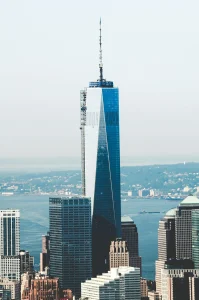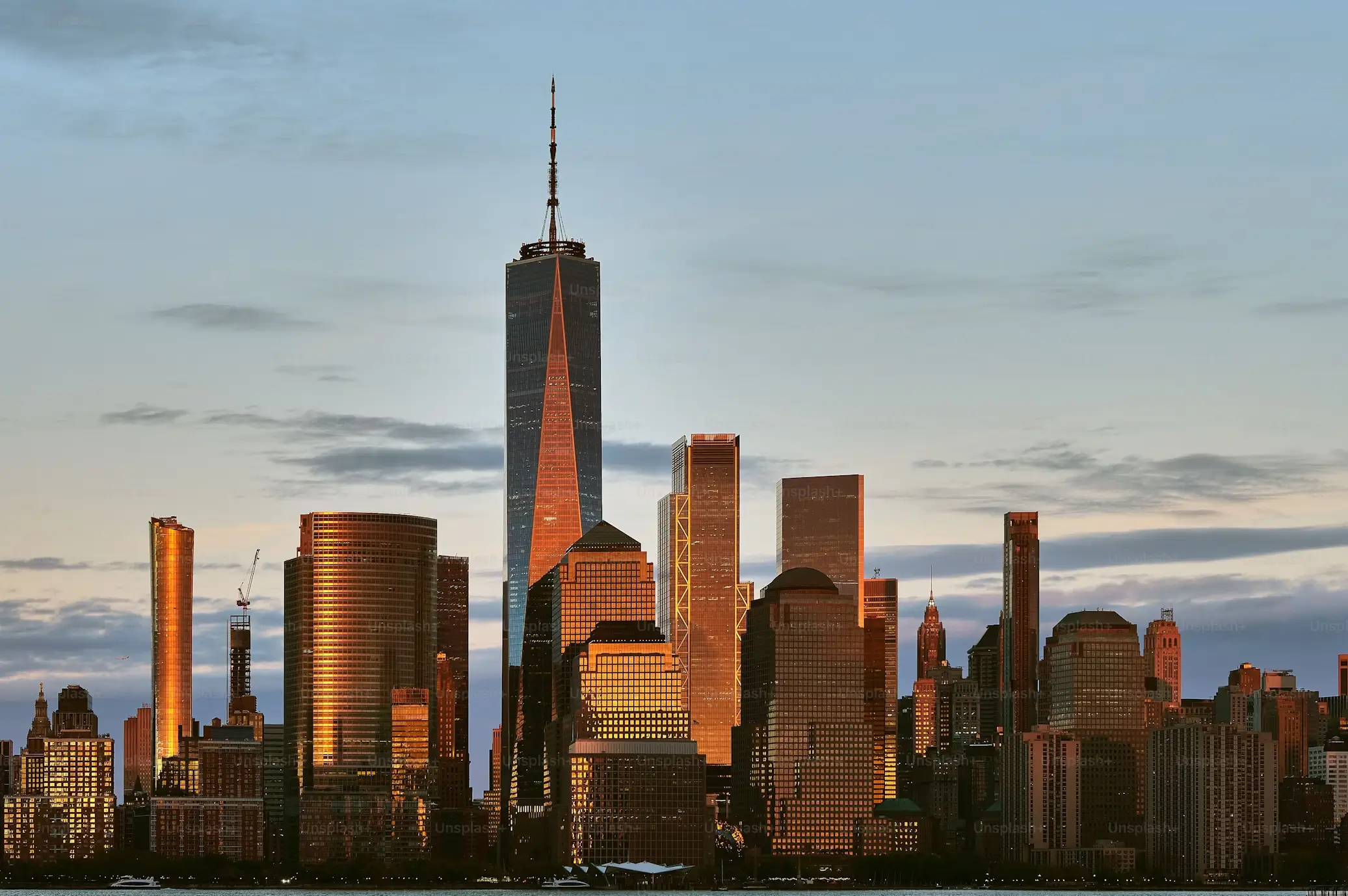Located at the heart of Lower Manhattan, One World Trade Center (1 WTC) is not just one skyscraper but a monument to resilience, rebirth and regeneration. At 1,776 feet tall (a design choice meant to commemorate the year of American independence), it is largest building in the United States and anyone in the Western Hemisphere. One World Trade Center, which sits on the site of the former Twin Towers and stands where other 110 floors would be high in the wake of 9/11/2001 tragedies for the city and nation.
Welcome to our new post where we will talk about the past, design, construction and cultural background of this architectural triumph and why everyone who will goes to New York City has to visit there.
Historical Context
To fully appreciate One World Trade Center, we must first reflect on its history. The original World Trade Center Twin Towers, completed in the early 1970s, were iconic landmarks of the New York City skyline. However, on September 11, 2001, they became the target of a devastating terrorist attack that claimed thousands of lives and left a void in the city’s heart.
In the aftermath, the decision to rebuild wasn’t just about replacing what was lost; it was about creating a powerful symbol of resilience and unity. The new World Trade Center complex was envisioned as a tribute to the victims and a beacon of hope for the future. One World Trade Center, often referred to as the Freedom Tower, became the centerpiece of this vision.
All information about One World Trade Center at a glance:
| Category | Details |
|---|---|
| Name | One World Trade Center (1 WTC) |
| Nickname | Freedom Tower |
| Location | 285 Fulton Street, New York, NY, USA |
| Height | 1,776 feet (541 meters) |
| Significance of Height | Symbolizes the year of U.S. independence (1776) |
| Architect | David Childs (Skidmore, Owings & Merrill – SOM) |
| Construction Timeline | 2006–2014 |
| Opening Date | November 3, 2014 |
| Purpose | Commercial offices, observation deck, and symbolic landmark |
| Observation Deck | One World Observatory (Floors 100–102) |
| LEED Certification | LEED Gold (Sustainable and energy-efficient building) |
| Key Features | Reinforced concrete core, spire, glass façade, safety innovations |
| Tenants | Media companies, tech firms, government agencies, and more |
| Architectural Style | Modern, minimalist with symbolic design |
| Construction Cost | $3.9 billion |
| Tallest Rank | Tallest building in the U.S. and Western Hemisphere |
| Part of Complex | World Trade Center complex, including 9/11 Memorial & Museum |
| Symbolism | Resilience, hope, and renewal after the 9/11 attacks |
| Tourism | Attracts millions of visitors annually for its observatory and memorial |
Design and Architecture
Architectural Vision
Designed by David Childs of the renowned architectural firm Skidmore, Owings & Merrill (SOM), One World Trade Center combines sleek modernity with deep symbolism. Every element of its design reflects strength, freedom, and renewal. The building’s height of 1,776 feet was chosen to symbolize the year of American independence, making it a powerful statement of national pride.
Structural Features
The tower’s design is strikingly simple yet elegant. Its base is a square footprint, the same as the original Twin Towers, but as it rises, the structure transitions into an octagon and then a glassy spire. This creates a crystalline appearance that reflects sunlight during the day and glows at night, making it a standout feature of the Manhattan skyline.
Safety Innovations
After the events of 9/11, safety was a top priority in the tower’s design. One World Trade Center boasts a reinforced concrete core that houses its elevators, stairwells, and utilities, making it one of the safest skyscrapers in the world. Other innovations include wider staircases, enhanced fireproofing, and air filtration systems designed to withstand chemical or biological attacks.
Sustainable Design
One World Trade Center is also a model of sustainability. It was built with LEED Gold certification, incorporating energy-efficient systems, rainwater recycling, and sustainable building materials. Its glass façade not only enhances its aesthetic appeal but also maximizes natural light, reducing energy consumption.
Construction Journey
The construction of One World Trade Center was a monumental task that spanned nearly a decade, from 2006 to 2014. The project faced numerous challenges, including engineering complexities, political debates, and budget constraints. Despite these hurdles, the building was completed in time to open to the public on November 3, 2014.
One of the most significant milestones was the installation of the spire in 2013, which brought the building to its symbolic height of 1,776 feet. The spire also serves as a broadcast antenna, making it both a functional and symbolic feature.

Cultural and Symbolic Significance
One World Trade Center is more than just a building; it’s a symbol of resilience and hope. For many, it stands as a memorial to the lives lost on 9/11 and a testament to the strength of the human spirit. Its nickname, the Freedom Tower, reflects its role as a beacon of liberty and perseverance.
The building has also become an integral part of New York City’s identity. It reminds residents and visitors alike of the city’s ability to rebuild and thrive, even in the face of unimaginable tragedy.
Features and Attractions
One World Observatory
One of the most popular features of One World Trade Center is the One World Observatory, located on floors 100–102. Visitors can enjoy breathtaking, 360-degree views of New York City, including landmarks like the Statue of Liberty, Central Park, and the Brooklyn Bridge. The observatory also features interactive exhibits and a high-tech elevator experience that showcases the evolution of New York’s skyline over centuries.
Office Space and Tenants
One World Trade Center is not just a tourist attraction; it’s a thriving commercial hub. The building houses offices for major companies, including media outlets, tech firms, and government agencies. Its state-of-the-art facilities make it one of the most sought-after business addresses in the world.
Sustainability Features
The tower’s green technologies, such as energy-efficient lighting and advanced HVAC systems, make it one of the most environmentally friendly skyscrapers in the world. These features align with New York City’s broader commitment to sustainability and climate-conscious development.
Comparisons to Other Tall Buildings
As the tallest building in the United States, One World Trade Center surpasses other iconic skyscrapers like the Willis Tower (formerly Sears Tower) in Chicago and Central Park Tower in New York. Globally, it ranks among the tallest buildings, though it is outpaced by giants like the Burj Khalifa in Dubai and the Shanghai Tower in China.
Fun Facts and Trivia
- The height of 1,776 feet was chosen to symbolize the year of the Declaration of Independence.
- The tower’s glass façade covers an area of approximately 600,000 square feet.
- The spire itself is 408 feet tall and weighs 758 tons.
- The building’s nickname, Freedom Tower, was initially its official name before being rebranded as One World Trade Center.
Visiting One World Trade Center
If you’re planning a trip to New York City, visiting One World Trade Center should be at the top of your list. Here are some tips:
- Getting There: The building is located at 285 Fulton Street in Lower Manhattan. It’s easily accessible via subway, bus, or taxi.
- Best Time to Visit: Early mornings or weekdays are ideal to avoid crowds at the observatory.
- Nearby Attractions: Don’t miss the 9/11 Memorial & Museum, located adjacent to the tower, or the Oculus, a stunning transportation hub and shopping center.
Conclusion
One World Trade Center is more than just a skyscraper; it’s a powerful symbol of resilience, innovation, and hope. Rising from the ashes of tragedy, it stands as a testament to the enduring spirit of New York City and the United States. Whether you’re admiring its architectural beauty, learning about its history, or taking in the views from the observatory, visiting One World Trade Center is an unforgettable experience. visit website: https://www.wtc.com/about/buildings/1-world-trade-center
FAQ:
1. How tall is One World Trade Center, and why is its height significant?
One World Trade Center stands at 1,776 feet (541 meters), including its spire, making it the tallest building in the United States and the Western Hemisphere. The height is significant because it symbolizes the year 1776, when the United States declared independence, making the building a powerful symbol of freedom and resilience.
2. What is the purpose of One World Trade Center?
One World Trade Center serves multiple purposes:
- It is a commercial office building, housing tenants such as media companies, technology firms, and government agencies.
- It is also a tourist destination, featuring the One World Observatory, which offers breathtaking views of New York City and beyond.
- Additionally, it stands as a symbol of hope and renewal, honoring the legacy of the original Twin Towers and the lives lost on September 11, 2001.
3. What can visitors experience at the One World Observatory?
The One World Observatory, located on floors 100–102, provides an unforgettable experience, including:
- Panoramic views of New York City, stretching up to 50 miles on a clear day.
- A high-tech elevator ride called SkyPod, which shows the transformation of New York City’s skyline over centuries.
- Interactive exhibits, such as the City Pulse, where guides provide insights about NYC landmarks.
- A dining experience at ONE Dine, offering meals with a view.
4. Is One World Trade Center safe?
Yes, One World Trade Center is one of the safest skyscrapers in the world. It features:
- A reinforced concrete core for added structural integrity.
- Wider, pressurized stairwells for faster evacuation.
- Advanced fireproofing and air filtration systems.
- State-of-the-art security measures, including surveillance and restricted access areas.
5. How does One World Trade Center honor the victims of 9/11?
One World Trade Center is part of the World Trade Center complex, which includes the 9/11 Memorial & Museum. The building itself represents resilience and renewal, while the memorial features two large reflecting pools with the names of the victims inscribed around them. The site serves as a place of remembrance and reflection for visitors from around the world.

